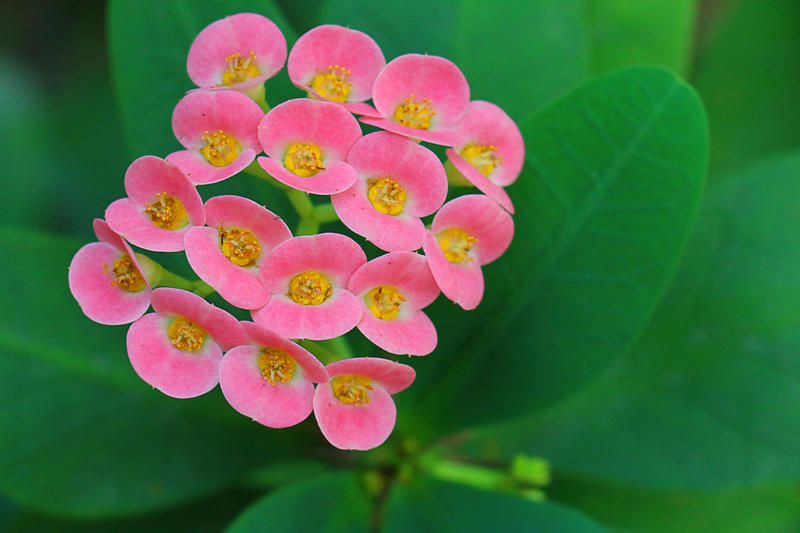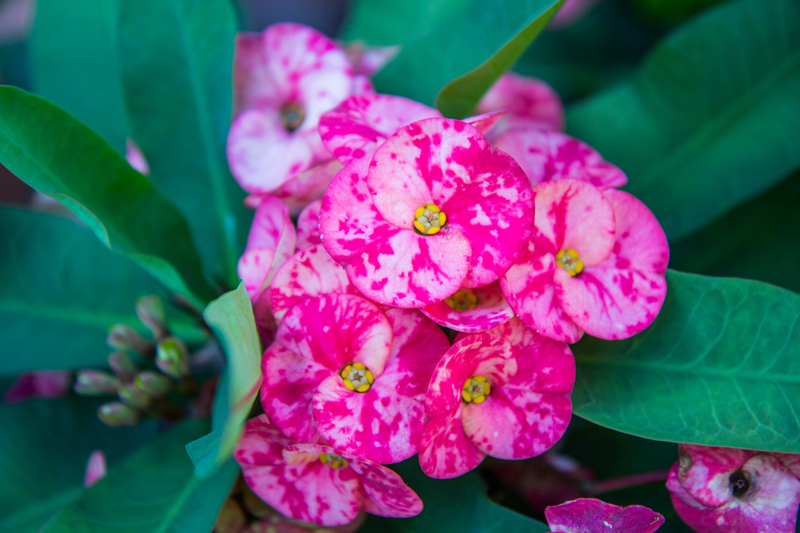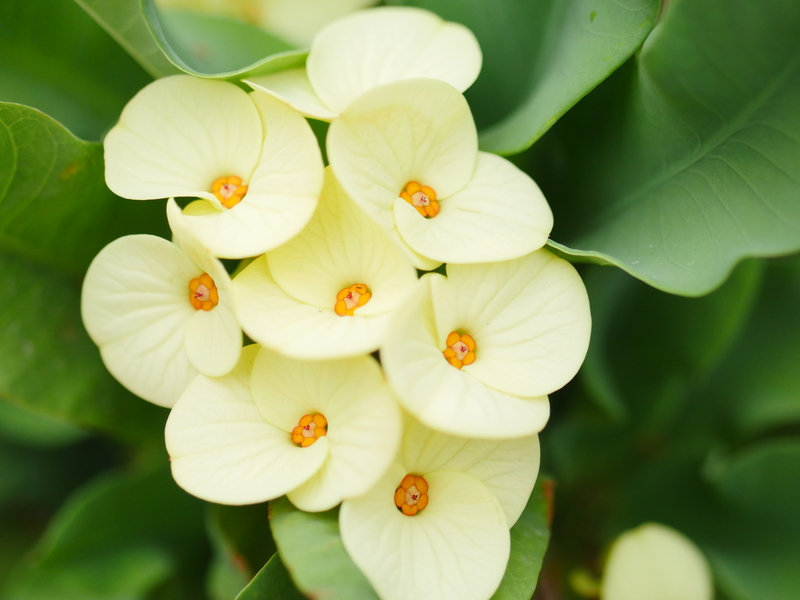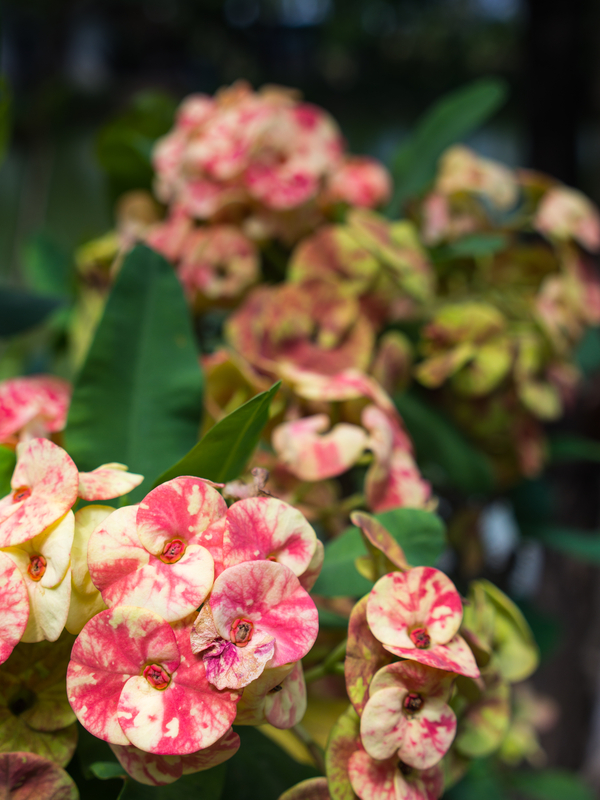HousePlantJoy is supported by our audience. When you purchase through one of our links, we may earn a small affiliate commission. As an Amazon Associate I earn from qualifying purchases. Your cost is not affected.
==================
Crown of thorns, with a biblically-inspired name and due to its distinctive characteristics, is a perfect succulent to spruce up your home!
Indoor houseplants are a great source of pleasure. There is nothing quite like indoor houseplants that can add more comfort and beauty to your home or office. You can put them anywhere in your home or office, and they will thrive. While growing succulents like the crown of thorns in your home or office is aesthetically pleasing, they are also a great source of various health benefits.
The Crown of thorns is one of the succulents that bloom year-round. The thick and bright green leaves along the stem and showy bracts in orange, pink, red, or yellow are a real treat to the eyes. With suitable condition and care, the indoor houseplant is an excellent addition to add some greenery to your landscape.
About Crown of Thorns
The crown of thorns is an herbaceous, deciduous perennial succulent that produces bright green leaves and greenish blooms. The flowers are surrounded by long-lasting, bright bracts of yellow or red. It is a loosely, irregularly, and spiny-shaped houseplant and is believed to have used its stems in Christ’s crown of thorns.
Also known as Christ thorn or Christ plant, the crown of thorns is a flowering succulent native to Madagascar. It is a slow-growing plant that grows as a shrub reaching 6 feet. However, planting the crown of thorns plant indoors means it can grow up to2 feet.
| Name | Crown of Thorns, Christ Thorn, Christ Plant |
| Botanical Name | Euphorbia Milii |
| Type | Succulent |
| Family | Euphorbiaceae |
| Size | Up to 6 Feet Outdoors and 2 feet Indoors |
| Soil | Well-Drained |
| pH | Neutral, Acidic |
| Sunlight | Partial, Full |
| Bloom Season | Year-Round |
| Hardiness Zones | USDA 9-11 |
| Blooms Color | Pink, White, Red, Yellow, Orange |
The plant strikes green, thick leaves and small colorful flowers. It also features sharp, spiny branches and stems covered in thorns. If you plan to grow it indoors, keep in mind that it is a highly toxic plant that can be poisonous to humans and animals if ingested.
How to Grow Crown of Thorns?
While the crown of thorns plant can grow as a woody shrub, the succulent also makes a perfect houseplant for homes and offices. It thrives in the same room temperature that we enjoy and can endure inadequate humidity indoors, especially during the winter.
In addition, it is worth noting that the crown of thorns is perennial in 9-11 USDA hardiness zones. However, in regions with colder climates, you can grow it as an indoor houseplant. While growing outdoors, ensure to provide the plant with plenty of room.
Moreover, it makes an excellent specimen plant. Additionally, renewal pruning at the season’s end can help your plant produce new branches and stems.
Furthermore, if you want to grow it in a container, you can keep it outdoors wherever you want color or interest. However, it is also essential to bring it indoors during nighttime when the temperature dips below 50 degrees. It can be put indoors year-round near a bright, sunny window.
It is also pertinent to mention that crown of thorns plant can repeat its blooms throughout the year. While the actual flowers strike paltry green centers, they are fenced by bracts, looking like colorful petals. Moreover, despite having thorns, the succulent is incredibly easy to handle by holding it from its leafy stems or roots.
Here are the requirements to keep your crown of thorns thriving:
1. Light
As with any other flowering succulent, light is an essential factor for the crown of thorns to make it produce stunning flowers. Keep in mind that the better the exposure is, the more your plant will grow. It requires direct, bright sunlight to bloom reliably.
So, it is essential to place your plant where it can get at least four hours of direct sunlight. For instance, put it under the full sun if you are growing it outdoors. Similarly, indoor growers can place it near a south or west-facing window during winter.
2. Soil
Soil is probably the second-most important factor in keeping your flowering plant thriving. If you plan to grow your crown of thorns plant outdoors, ensure to place it in well-draining soil and full sun. However, if your region has dry climates, ensure to provide your plant with mid-day shade. It will help your plant with better blooms.
Moreover, this succulent is among the most adaptable houseplants. Providing it with a well-draining cactus potting mix soil will encourage healthy growth. Furthermore, avoid planting it in a pot or container a couple of inches larger than the root ball. Excess soil for the crown of thorns is a killer as it can retain water, causing root rot and eventually damaging or killing your plant.
3. Water
Like many other succulents, the crown of thorns plant will also thrive even if it doesn’t get adequate watering. It is essential to water your plant only when the soil is dry, about an inch below the surface. Also, ensure to water your plant thoroughly and allow excess water to drain.
As mentioned earlier, excess watering can cause root rot, so be sure not to let your plant sit in the water for longer periods. Keep in mind that it will go semi-dormant in the winter season. During cooler temperatures, reduce the frequency of water and do not fertilize.
4. Humidity and Temperature
Getting at least half a day of direct, bright sunlight exposure is one of the significant needs for your crown of thorns plant. It also means that placing your succulent indoors in temperatures between 65-75 degrees will help it grow healthy.
Moreover, you shouldn’t worry about lowering the thermostat at night. Note that your crown of thorns plant can easily handle temperatures as low as 50 degrees Fahrenheit.
5. Fertilizing Crown of Thorns
While the crown of thorns has minimal nourishment requirements, feeding your plant with a slow-release fertilizer is a good idea. Although the succulent can have healthy growth without feeding fertilizer, providing an occasional, diluted dose of fertilizer is recommended to improve its bloom production.
Moreover, when choosing a fertilizer for your crown of thorns, pick one without boron, as the plant can react sensitively to these micronutrients. In addition to that, this succulent is a slow grower and does not require heavy fertilizing. If you plan to grow it as a landscape plant, a balanced diluted solution (10-10-10) once a month during spring and summer can improve its growth.
Furthermore, if you use a granulated fertilizer, provide it with 3 to 5 tablespoons per square foot.
6. Pruning Crown of Thorns Plant
Without proper care, your succulent may become leggy. Regular pruning is essential for the crown of thorns to encourage new, leafy, and branching growth. As a houseplant, it is also advised to prune your plant regularly to maintain a compact shape.
However, ensure not to lop off any healthy buds when pruning. Whether you raise it outdoors or indoors, ensure to protect your hands, eyes, and skin from its latex sap.
7. Potting and Repotting
Since the houseplant is easy to report because of its slow growth, it is highly recommended to repot it every 2-3 years. However, when repotting, ensure to wear a pair of gloves and eye gear. Gently remove the houseplant from its container, loosen the roots, and place it in a container that should be 2-3 inches larger in diameter than the previous one.
Moreover, it is also advised to use a cactus-specific potting mix. After repotting your succulent to a new pot, water it thoroughly.
How to Propagate Crown of Thorns?
Generally, the crown of thorns plant is propagated through cuttings. It is a quick technique to establish your plant. So, do these succulents have seeds, and can you propagate them through seeds? Well, seed propagation is possible if your plant blooms because that’s when they have seeds.
However, keep in mind that germination is unreliable, so the best way to propagate your crown of thorns plant is through cuttings.
When to Propagate?
Keep in mind that crown of thorns cuttings needs bright light and warm conditions to produce roots. It means spring and summer are the best times to propagate thorns’ crowns. If you take cuttings in colder temperatures (autumn or winter), they won’t have enough time to root and is likely to produce an unhealthy, short-living plant.
Here is how you can propagate your succulent:
Crown of Thorns Cuttings
As stated earlier, the succulent is native to Madagascar and was brought to the US as a novel plant. They can bloom year-round as long as they are exposed to a period of wet and a period of dry. Since its stems and leaves have a latex sap that some people might find sensitive, it is advised to wear gloves before taking cuttings.
Also, remember that the best time to take cuttings from your houseplant is spring and summer because that’s when the active growth period starts.
Moreover, use a clean, sharp razor or knife to take cuttings and prevent damage and disease. In addition to that, also make sure to cut straight across the leaf tip, taking a 3-4 inches long cutting. Once you are done, spray some water on the end of the parent cut to prevent the leakage of latex sap.
Secondly, when you have the cuttings from your crown of thorns plant, it is essential to lay them on paper and place them in a cool, dry place, allowing the cut ends to callus. This step will encourage cells that can become roots while eliminating the risk of rot when placing the cuttings into the soil. After a couple of days, you may see a puckered and grayish-white end.
Crown of Thorns Plant Propagation from Cuttings
It is easier to propagate your succulent from cuttings compared to propagation from seeds. Keep in mind that seed propagation can take months or may not germinate if the conditions are not ideal.
Also, note that cuttings require an excellent medium of even sand and peat that has been moistened earlier. Set various cuttings into a 5-inch container for quicker and fuller effects.
Now, it’s time to put the callused end into the medium and cover it with soil so the cuttings can stand up. It is essential to keep the medium moisturized while avoiding excessive water. It can take up to 14 weeks before roots are established. However, your succulent might flower shortly after settling.
Propagation from Seeds
It is worth mentioning that the crown of thorns plant does have seeds if they bloom, so it is possible to propagate from seeds. However, it is also pertinent to mention that Euphorbia seeds are viable for only a short period and must be sown immediately. Additionally, you can pollinate your succulent by hand to encourage it to produce seeds. In this regard, use some brush to gather and transmit pollen from one flower to another.
If you notice any developing fruiting capsule, let it ripen and then remove and split it over a newspaper to gather seeds. You can use the same medium as you would for cuttings, but in flats. Now, sow the seeds on the soil surface and use a thin layer of sand as a cover. Moreover, keep the flats moist with a transparent lid and place them in bright light on a heated.
Once it shoots baby succulents, remove the lid and mist the soil, keeping the surface wet. You can transplant your baby succulents as soon as you spot a pair of leaves.
Potting and Repotting
Your crown of thorns plant can experience a few serious issues. A few of them include:
· Yellow Leaves
Leaves turning yellow are among the most common problems for the crown of thorns plants. The bright color of your succulent can brighten if it doesn’t get proper care and maintenance. The houseplant leaves can turn yellow and fall off quicker than usual.
A few reasons that can cause leaves to turn yellow include:
Water Deficiency: One of the significant reasons leaves turn yellow. In addition to that, other stress factors, such as poor soil quality, frequent temperature changes, etc., can also make leaves turn yellow.
Lack of Sunlight: Since crown of thorns leaves flourish best in bright direct sunlight, inadequate exposure to bright, direct sunlight can cause leaves to turn yellow. Moreover, protect your outdoor plant from frost during cold temperatures, or the leaves will turn yellow, making it hard for your plant to survive.
Lack of Nutrients: Another possible reason can be the lack of nutrients.
In order to prevent leaves from turning yellow, ensure to follow a proper care routine. Here are a few steps that can help overcome the problem:
- Water your plant regularly. Generally, watering your succulent once a week is sufficient.
- Avoid adding any fertilizers during the winter months. Also, ensure to use appropriate potting soil. Adding pumice, perlite, or sand to the soil can help improve drainage.
- Peat moss is excellent for providing your plant with nutrients.
· Root Rot
Specimen sitting in too moist or waterlogged soil for longer periods is another common issue that can potentially kill your succulent. Symptoms include stunted growth, leaves turning yellow, and a rotten brown caudex.
In this case, take your container plant out of its pot and examine its health below the soil line. If you spot yellow tinge roots, that’s fine. However, immediate action is needed if you notice brown, mushy roots.
· Bacterial Leaf Spots
Crown of thorns plants is semi-evergreen, meaning they can produce small leaves and pretty little blooms all year round. Unfortunately, your plant can experience bacterial leaf spots caused by bacteria known as Xanthomonas.
You might suffer from this bacterial disease if you notice spots on your succulent leaves. However, another possible reason could be an injury or fungal infection. In order to address the issue, examine the shape. Bacterial leaf spot disease causes spots that follow the leaves’ veins. Moreover, this pattern will produce angular shapes to the spots with grayish brown color, developing yellow holes.
Treatment
In order to protect your plant from bacterial leaf spots, it is essential to remove plants and cut off affected leaves to prevent spreading them to your other plants. Avoid overhead irrigation and ensure that your plants have enough space between them for better airflow. Moreover, sanitize any tools you use on affected plants.
· Pests and Diseases
The crown of the thorns plant is susceptible to various pests and fungal diseases. It includes spider mites, mealybugs, etc. The best way to protect your plant from pests and diseases is to limit watering and prevent the development of pests by pruning your plant’s old and damaged branches.
Remember that damaged branches can be a favorite hiding place for hazardous insects. So, ensure to prune the stem at its origin point to encourage newer, healthier growth.
Considering adding a Crown of Thorns plant?
Crown of thorns is a fantastic houseplant that can bloom all year round. It is a low-maintenance succulent and can be grown as an indoor and outdoor plant. However, since ingestion of the crown of thorns plant is toxic to humans and animals, ensure to keep it away from your kids and pets.
You Might Also Like:













